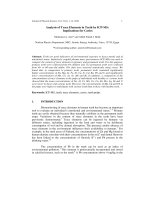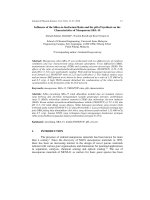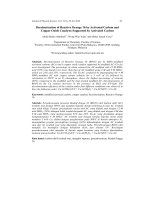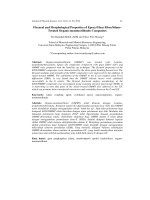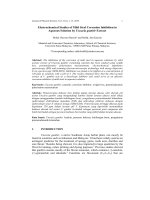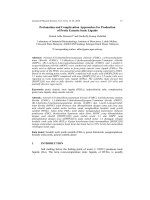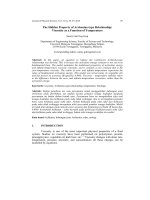Báo cáo vật lý: "Polymerisation of Protonic Polyaniline/Multi-Walled Carbon Nanotubes-Manganese Dioxide Nanocomposites" doc
Bạn đang xem bản rút gọn của tài liệu. Xem và tải ngay bản đầy đủ của tài liệu tại đây (381.83 KB, 8 trang )
Journal of Physical Science, Vol. 20(1), 27–34, 2009 27
Polymerisation of Protonic Polyaniline/Multi-Walled Carbon
Nanotubes-Manganese Dioxide Nanocomposites
Saiful Izwan Abd Razak, Abdul Latif Ahmad and Sharif Hussein Sharif Zein
*
School of Chemical Engineering, Engineering Campus, Universiti Sains Malaysia,
14300 Nibong Tebal, Pulau Pinang, Malaysia
*Corresponding author:
Abstract: This study reports the synthesis and characterisation of a ternary
nanocomposite of polyaniline (PANI), multi-walled carbon nanotubes (MWCNTs) and
manganese dioxide (MnO
2
). MnO
2
successfully filled the cavities between the MWCNTs.
In situ polymerisation of aniline in the presence of MWCNTs-MnO
2
was done to form a
ternary nanocomposite. The ultraviolet-visible (UV-vis) spectrum shows that MnO
2
filling
does not significantly change the electronic transition of the nanocomposite. The infra-
red (IR) spectrum shows that the nanocomposite is rich in quinoid rings of PANI.
Electron microscopy reveals the MnO
2
filling and coating of PANI. The ternary
nanocomposite showed high electron conductivity compared to neat PANI and PANI/
MWCNTs without MnO
2
.
Keywords: conducting polymer, polyaniline, multi-walled carbon nanotubes, manganese
dioxide, nanocomposites
Abstrak: Kajian ini melaporkan pencirian dan sintesis kompositnano terner yang terdiri
daripada polianilin (PANI), tiub nanokarbon banyak dinding (MWCNTs) dan manganese
dioksida (MnO
2
). MnO
2
telah berjaya mengisi ke dalam ruang kosong MWCNTs.
Pempolimeran telah dijalankan dengan kaedah in situ dengan kehadiran MWCNTs-
MnO
2
untuk membentuk kompositnano terner. Spektra ‘UV-visible’ menunjukkan bahawa
pengisian MnO
2
tidak mengubah transisi elektronik kompositnano dengan ketara. Spektra
infra merah (IR) menunjukkan kompositnano tersebut kaya dengan cincin quinoid PANI.
Mikroskop elektron menunjukkan salutan PANI dan pengisian MnO
2
. Kompositnano
terner tersebut menunjukkan pengaliran elektron yang lebih tinggi berbanding PANI dan
juga PANI/MWCNTs tanpa MnO
2
.
Kata kunci: polimer berpengalir, polianilin, tiub nanokarbon banyak dinding, manganese
dioksida, kompositnano
1. INTRODUCTION
Since their discovery by Iijima
1
, carbon nanotubes (CNTs) have received
much attention for their possible use in fabricating a new classes of advanced
material, due to their unique structural, optical, mechanical and electronic
properties.
2–4
Introducing CNTs into a polymer matrix improves the properties of
Polymerisation of PANI/MWCNTs-MnO
2
28
the original polymer.
5
Among these polymer/CNTs nanocomposites, many have
focused on the combination of CNTs and conducting polymers.
6, 7
PANI is one of
the conducting polymers that has potential in the near term, due to its good
processability, environmental stability and reversible control of conductivity both
by charge-transfer doping and protonation.
8
The use of PANI together with CNTs
to form nanocomposites could result in the formation of ternary materials with
extraordinary properties.
9
Though several studies have been done on PANI/CNTs
nanocomposites, the electron conduction and stability of the nanocomposites still
remain an issue.
10
The aim of this study is to fill the MWCNTs with MnO
2
in
order to improve the interaction between the MWCNTs and PANI, which may
lead to an increase in the electron conductivity. Potential applications of this
nanocomposite are in high energy portable electronics and supercapacitor
properties.
11
This study also reports the synthesis of HCl-doped PANI in its
emaraldine salt by in situ chemical oxidative polymerisation of aniline to form a
ternary nanocomposite of PANI /MWCNTs-MnO
2
.
2. EXPERIMENTAL
A complete description of the purification and filling of MWCNTs with
MnO
2
has been explained in detail elsewhere.
12
The in situ nanocomposites were
synthesised by the polymerisation of aniline (ACS grade, Acros) with potassium
dichromate (R&M) as the oxidant in the presence of the MWCNTs-MnO
2
, as
described in Zein et al.
12
A solution of HCl (Aldrich) containing a predetermined
amount of MWCNTs-MnO
2
was sonicated at room temperature. Aniline
monomer was dissolved in HCl solution and added to the MWCNTs-MnO
2
suspension and stirred. The oxidant, potassium dichromate, was dissolved in HCl
solution and then slowly added dropwise to the reaction mixture. After the
suspension became green, indicating the formation of PANI in its emeraldine salt
form, the nanocomposites obtained were filtered, washed several times with
deionized water and dried for 24 h. The same method was used for neat PANI
and PANI/MWCNTs. UV-vis spectra were performed on a Shimadzu UV-visible
spectrophotometer with the samples suspended in n-methylpyrrolidinone (NMP).
IR spectra were obtained by means of Fourier transform infra red spectroscope
(FTIR) from Perkin Elmer. The morphology analysis of the nanocomposites was
carried out using a variable pressure field emission scanning electron microscope
(VPFESEM) and transmission electron microscope (TEM). The electrical
conductivity was measured by a high resistance meter from Advantest.
Journal of Physical Science, Vol. 20(1), 27–34, 2009 29
3. RESULTS AND DISCUSSION
UV-vis spectroscopy was utilised to understand the electronic states of
PANI in PANI/MWCNTs and PANI/MWCNTs-MnO
2
. The HCl-doped PANI
[Fig. 1(a)] showed a characteristic band for the polaronic transition (polaron-π*
transition) around 450 nm,
13
indicating that the resulting PANI emaraldine salt
was in the doped state. The peak around 290 nm represents the π-π* electron
orbital transition along the backbone of the PANI chain. As MWCNTs and
MWCNTs-MnO
2
were incorporated with PANI [Figs. 1(b) and (c)], the
characteristic peak assigned to the polaron-π* transition of the PANI chain
shifted to longer wavelengths, indicating the interaction between quinoid rings
and MWCNTs.
14
The π-π* transition of PANI in the nanocomposites was also
shifted to longer wavelengths. The MnO
2
[Fig. 1(c)] filling does not seem to
cause any significant changes on the electronic transition of the nanocomposites.
Figure 2 shows the FTIR spectrum for the HCl-doped PANI. The
spectrum exhibits the clear presence of benzoid at 1476 cm
–1
and the quinoid ring
vibration at 1557 cm
–1
, indicating the oxidation state of emaraldine salt of
PANI.
15
The strong band around 1141 cm
–1
is the characteristic peak of PANI
conductivity and is a measure of the degree of the delocalisation of electrons.
14
The very weak and broad band around 3000 cm
–1
is assigned to the N-H
stretching mode. Figures 3(a) and (b) show PANI/MWCNTs and
PANI/MWCNTs-MnO
2
, respectively. There were clear differences between these
and the spectrum of HCl-doped PANI (Fig. 2). The N-H stretching region near
3000 cm
–1
in both Figures 3(a) and (b) showed strong and broad peaks, but very
weak and broad peaks were present in the neat PANI spectrum. The interaction
between the MWCNTs and PANI may result in “charge transfer”, whereby the
sp
2
carbons of the MWCNTs compete with dopant ions [Cl
–
] and perturb the H-
bond, resulting an increase in the N-H stretching intensity.
16
Another difference
Figure 1: UV-vis spectra of: a) PANI, b) PANI/MWCNTs, and c) PANI/MWCNTs
-MnO
2.
Polymerisation of PANI/MWCNTs-MnO
2
30
Figure 2: FTIR spectrum of HCl-doped PANI.
that can be observed is the intensity ratio of the benzoid and quinoid bands. The
spectrum of pure PANI (Fig. 2) exhibits a clear difference in intensity; the
quinoid band is less intense than benzoid band. The benzoid/quinoid intensity
ratio for PANI/MWCNTs [Fig. 3(a)] is reduced considerably and almost equal
for PANI/MWCNTs-MnO
2
[(Fig. 3(b)]. This reveals that there are fewer benzoid
units in the nanocomposite of PANI/MWCNTs-MnO
2
compared to neat PANI.
This may suggest that the MnO
2
promotes and stabilises the quinoid ring
structure of the nanocomposite.
Figure 3: FTIR spectra of a) PANI/MWCNTs and b) PANI/MWCNTs-MnO
2
.
Journal of Physical Science, Vol. 20(1), 27–34, 2009 31
(a) (b)
(c) (d)
Figure 4: TEM images of: a) MWCNTs-MnO
2
and b) PANI/MWCNTs-MnO
2
, and SEM
images of: c) PANI/MWCNTs and d) PANI/MWCNTs-MnO
2
.
TEM images of the MWCNTs after being filled with MnO
2
are shown in
Figure 4(a). The filled MWCNTs show dark contrast, suggesting that the filling
of MnO
2
in the inner cavity of MWCNTs did take place. The outer walls of the
filled MWCNTs were smooth with no observable crystallised MnO
2
. Figure 4(b)
shows the ternary nanocomposite, PANI/MWCNTs-MnO
2
. It shows that the
PANI was uniformly coated on the surface of the MWCNTs-MnO
2
, forming a
tubular structure with a thickness of a few nanometers. Figure 4(d) reveals that
the PANI/MWCNTs-MnO
2
was well-dispersed. During the polymerisation, the
growing PANI polymer chains wedged away the MWCNTs-MnO
2
bundles and
then broke the bundles down into individual MWCNTs-MnO
2
. The interaction
between the quinoid ring of PANI and the MWCNTs-MnO
2
causes PANI
polymer chains to be adsorbed at the surface of MWCNTs, thus forming a tubular
core surrounding the MWCNTs-MnO
2
.
Polymerisation of PANI/MWCNTs-MnO
2
32
The electrical conductivities of neat PANI, PANI/MWCNTs and
PANI/MWCNTs-MnO
2
were measured according to the standard four-point
probe method. The conductivity of the samples were measured and calculated to
be 38.34 Scm
–1
, 50.56 Scm
–1
and 57.74 Scm
-1
for neat PANI, PANI/MWCNTs
and PANI/MWCNTs-MnO
2
, respectively. The enhancement in conductivity of
PANI/MWCNTs compared to neat PANI is due to the charge transfer effect from
the quinoid rings of the PANI to the MWCNTs. Furthermore, the MWCNTs may
serve as “conducting bridges”, connecting the PANI conducting domains. A
further increase in conductivity was observed for PANI/MWCNTs-MnO
2
, which
may be due to the role of MnO
2
in stabilising the interaction between the PANI
and MWCNTs, thus leading to an increase in electron conductivity.
4. CONCLUSION
Ternary nanocomposites of PANI/MWCNTs-MnO
2
were successfully
prepared through the in situ chemical oxidative polymerisation of aniline.
PANI/MWCNTs-MnO
2
showed good interaction, based on the shift in the
electronic transition described by UV-vis and FTIR spectra, which showed that
PANI/MWCNTs-MnO
2
was rich in quinoid rings. TEM revealed the filling of
MWCNTs with MnO
2
and the uniform coating of PANI. SEM showed less
bundling among the nanocomposites. The conductivity of PANI/MWCNTs-
MnO
2
was higher than that of neat PANI and PANI/MWCNTs. PANI/MWCNTs-
MnO
2
showed better results than neat PANI and PANI/MWCNTs without MnO
2
.
Further study should focus on investigating the interaction mechanism and
possible applications of this PANI/MWCNTs-MnO
2
nanocomposite.
5. ACKNOWLEDGEMENTS
Financial support provided by the Ministry of Science, Technology and
Innovation through the Science Fund (Project No. 03-01-05-SF0126) and a
short-term USM grant (Project No. 304.PJKIMIA.6035217) are gratefully
acknowledged.
6. REFERENCES
1. Iijima, S. (1991). Helical microtubules of graphitic carbon. Nature, 354
(6348), 56–58.
2. De Heer, W.A., Chatelain, A. & Ugarte, D. (1995). A carbon nanotube
field emission electron source. Sci., 1270(5239), 1179–1180.
Journal of Physical Science, Vol. 20(1), 27–34, 2009 33
3. Odom, T.W., Huang, J.L., Kim, P. & Lieber, C.M. (1998). Atomic
structure and electronic properties of single-walled carbon nanotubes.
Nature, 391(6662), 62–64.
4. Santos, C.V., Hernandez, A.L.M., Fisher, F.T., Ruoff, R. & Castano,
V.M. (2003). Improvement of thermal and mechanical properties
of carbon nanotube composites through chemical functionalization.
Chem. Mater., 15(23), 4470–4475.
5. Ajayan, P.M., Stephan, O., Colliex, C. & Trauth, D. (1994). Alligned
carbon nanotubes arrays formed by cutting polymer resin-nanotube
composite. Sci., 265(5176), 1212–1214.
6. Wang, C.Y., Mottaghitalab, V., Too, C.O., Spinks, G.M. & Wallace,
G.G. (2007). Polyaniline and polyaniline-carbon nanotubes composite
fibres as battery materials in ionic liquid electrolyte. J. Power Sources,
163(1), 1105–1109.
7. Kim, J.Y., Kim, K.H. & Kim, K.B. (2008) Fabrication and
electrochemical properties of carbon nanotubes/polypyrrole composite
film electrodes with controlled pore size. J. Power Sources, 176(1),
396–402.
8. Heeger, A.J. (2001). Semiconducting and metallic polymers:
The fourth generation of polymeric materials. J. Phys. Chem. B,
105(36), 8475.
9. Konyushenko, E.N., Stejskal, J., Trchova, M., Hradil, J., Kovarova, J.,
Prokes, J., Cieslar, M., Hwang, J.Y., Chen, K.H. & Sapurina, I. (2006).
Multi-walled carbon nanotubes coated with polyaniline. Polymer, 47(16),
5715–5723.
10. Peng, C., Jin, J. & Chen, G.Z. (2007). A comparative study on
electrochemical co-deposition and capacitance of composite films
of conducting polymers and carbon nanotubes. Electrochim. Acta,
53(2), 525–537.
11. Jiang, J. & Kucernak, A. (2002). Hydrated Mn(IV) oxide-exfoliated
graphite composites for electrochemical capacitor. Electrochim. Acta,
47(15), 2381.
12. Zein, S.H.S., Yeoh, L.C., Chai, S.P., Mohamed, A.R. & Mahayuddin,
M.E.M. (2007). Synthesis of manganese oxide/carbon nanotubes
nanocomposites using wet chemical method. J. Mat. Proc. Tech.,
190(1), 402–405.
13. Scherr, E.M., MacDiarmid, A.G., Monahar, S.K., Masters, J.G., Sun, Y.
& Tang, X. (1991). Polyaniline: Oriented films and fibers. Synt. Met.,
41(1), 735.
14. Xia, H. & Wang, Q. (2003). Preparation of conductive
polyaniline/nanosilica particle composites through ultrasonic irradiation.
J. Appl. Polym. Sci., 87(11), 1811–1817.
Polymerisation of PANI/MWCNTs-MnO
2
34
15. Quillard, S., Louarn, G., Lefrant, S. & MacDiarmid, A.G. (1994).
Vibrational analysis of polyaniline: A comparative study of
leucoemaraldine, emaraldine and pernigraniline bases. Phy. Rev. B,
50(17), 12496–12508.
16. Cochet, M., Maser, W.K., Benito, A.M., Callejas, M.A., Martinez, M.T.,
Benoit, J.M., Schreiber, J. & Chauvet, O. (2001). Synthesis of a new
polyaniline/nanotube composite: in situ polymerisation and charge
transfer through site-selective interaction. Chem. Commun., (16),
1450–1451.
